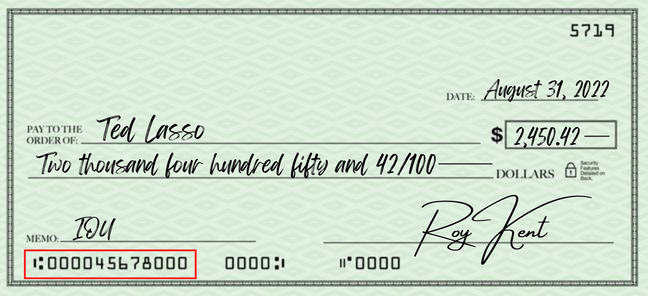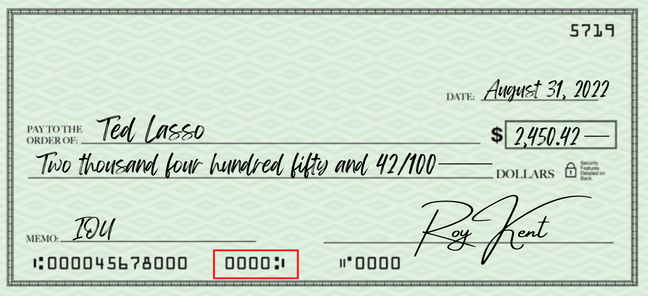If you can’t remember the last time you filled out a check, don’t sweat it. Thanks to credit cards and companies like Cash App, checks have certainly become less necessary in recent years. Nevertheless, there are still plenty of relevant uses for checks today.
For example, some businesses charge a fee for large purchases made on a debit or credit card, but won’t do so if you pay with a check. Not to mention, it’s more common to receive a check versus cash for birthday, holiday, or wedding gifts.
For these reasons and more, it’s important that you know how to fill out and read a check properly.
How To Fill Out a Check
There are six fields you’ll need to fill out to complete your check.
1. Date

First, in the upper right-hand corner of your check, you’ll write the date — typically the current date.
In some instances, you can also list a future date, if you don’t want the recipient to cash the check right away.
2. Payee

Next, you’ll write the name of the person or company receiving the check.
Your check should read “Pay To” or “Pay To The Order Of,” after which you will write in the name of the recipient. Pay attention to spelling here, since some banks may refuse to cash a check if the name is misspelled.
Lastly, if you choose to do so, you can write “Cash” on the payee line. This authorizes anyone who holds the check to cash it in, so do so only when absolutely necessary.
3 & 4. Amount (in Numbers and in Words)
When you’re specifying the value of your check, there are two fields to complete: one as the number written out in words, the other in numerical form.
Writing this information in two separate ways helps to ensure that the amount you want to pay is recorded accurately.
Numerical Value

Writing the numerical value is fairly self-explanatory. That said, make sure you include the correct punctuation and fill in the box completely to prevent someone from adding numbers and committing fraud.
If the numbers don’t take up the box completely, simply write a dash from the last number to the edge of the box.
Written Value

Some people find it difficult to record the amount they want to pay in written words. One easy way to simplify this step is to think about how you would say the number out loud.
For example, with $2,450, you’d say that as “two thousand four hundred fifty.” Again, remember to use the correct punctuation. Specifically, if you’re using a number between 21 and 99, you’ll typically need a hyphen (for example: fifty-two).
Finally, if the value of your number includes change, such as $0.42, write it out as a fraction. In this case, $0.42 would be written as “42/100.” Also, you should use the word “and” between dollars and cents.
So, if your check were for $5,302.55, you would write it as follows: “Five thousand three hundred two and 55/100.”
5. Memo

This is another relatively self-explanatory section. You’ll use this field on the check to identify the purpose of the check. For instance “February 2024 Rent” or “Happy birthday.”
The memo portion of your check matters more for your tracking than anything else, so don’t worry too much about what to write here.
6. Signature

The final section of your check to fill in is the signature. This is the most important field, because if you don’t sign the check, it cannot be cashed.
In fact, most banks will charge you a fee for writing an invalid check, since there’s an added inconvenience for them.
How to Read a Check
In addition to knowing what information to include in each of the six fields on your check, you should also understand the three numbers listed at the bottom of each check.
1. Bank Routing Number

The first number you’ll see listed, on the bottom left-hand corner of the check, is the bank routing number. This number is nine digits, and it’s used to identify the appropriate bank from which to pull the money.
(We’re obviously using a fake check in our example above, so don’t worry if the numbers don’t look the same as your real check!)
Account Number

Next, at the bottom middle of your check, you’ll find your individual checking account number. This number identifies your unique bank account.
Check Number

Lastly, the final number in the row at the bottom of your check (farthest to the right) is the check number. This helps you keep track of which check you use for which purpose.
This number is also located in the upper right-hand corner of the check.
Check Writing Tips
Keep Detailed Records
Make sure you track your check usage in a check register. This will help you make sure you never write a future check for more than you have available in your account. Additionally, since your bank statement will likely include just the check number and amount, tracking your check transactions will help you remember the purpose of each check you’ve used.
When recording information in your check register, be sure to include the amount paid, the check number, the date you wrote it, and information on what and who the check was for.
Know How to Void a Check
Sometimes when you want to set up recurring online payments (such as for a mortgage) or direct deposit from your employer, you may need a voided check to complete the process.
If this is the case, you’ll write “VOID” in large, block letters over the entire front and back of the check. Make sure you avoid covering the account number and bank routing number. Another option is to write “Void” in each of the check fields (“Pay To,” the date, the amount, etc.).
Additional Best Practices
- Always use a pen, never a pencil.
- Be sure to fill in the amount line completely.
- Avoid signing blank checks.
- Avoid using “Cash” in the “Pay To” field, unless absolutely necessary.
- Always fill out the signature portion of your check last and make sure that all of the information is correct before you sign.
Summary
Today, many Americans prefer to use debit or credit cards, automatic bill pay, and even cash over checks. Nevertheless, there are some scenarios where a check may be warranted, or even preferred.
Make sure you understand how to fill out a check properly, completing all six fields, and review safe practices for check writing, such as using a pen and filling out the signature portion last, to protect your bank account.
Check images: iQoncept/Shutterstock.com